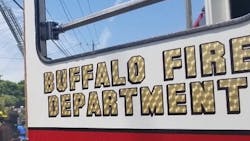BUFFALO, NY—As former emergency medical services (EMS) workers, Dave Hostler and Brian Clemency know how challenging it can be to maintain a healthy lifestyle while working long shifts at odd hours.
That's why the University at Buffalo researchers proposed a study aimed at understanding the nutrition practices of EMS workers.
Their proposal was one of three selected for $5,000 in pilot funding by the National Association of EMS Physicians (NAEMSP) and the Emergency Medicine Foundation (EMF), two national organizations that have provided grants for prehospital research.
"With this funding, we will be attempting to describe how EMS work affects eating habits. There is likely an effect of shift work and working conditions that lead to poor eating habits and/or food choices," explains Hostler, PhD, chair of exercise and nutrition sciences in UB's School of Public Health and Health Professions.
The study will recruit 20 nightshift and 20 dayshift EMS clinicians in Western New York.
"As a former paramedic, I know well that the unique lifestyle of an EMS provider makes it extraordinarily difficult to eat healthy," added Hostler, who has worked closely with emergency personnel in research studies in the two labs he leads at UB: the Center for Research and Education in Special Environments (CRESE) and the Emergency Responder Human Performance Lab.
While considerable work has been done with regard to firefighters, the UB study will be the first to examine the eating habits of EMS workers both on- and off-duty. The study will also shed more light on the prevalence of chronic health conditions among EMS clinicians compared to the general public.
Previous studies have linked shift work to a number of adverse health conditions. It's estimated that more than 70% of EMS shift workers are either overweight or obese, a rate that exceeds the general population.
The reasons are numerous. It's particularly challenging for night shift EMS workers to find healthy food selections. Moreover, EMS personnel who work in busy areas or for providers that station ambulances in specific locations typically do not have access to refrigeration or any way to heat up food.
"This typically results in the clinician relying on purchased food. Healthy options are often limited in fast food restaurants," said Clemency, DO, an associate professor of emergency medicine and director of the EMS Fellowship, both in the Jacobs School of Medicine and Biomedical Sciences at UB.
Clemency is a former EMT and firefighter who now also serves as medical director for more than 450 EMS providers from a variety of volunteer and career agencies in Western New York.
"I have seen firsthand in myself and in many of our EMS providers the challenges of living a healthy lifestyle while working outside of standard business hours," Clemency said. "Overeating and eating the wrong types of foods, combined with a sedentary lifestyle in between calls, can have a detrimental effect on provider health, which can also impact patient safety."
Boredom can also be problematic: When they're not providing patient care, EMS clinicians might have long gaps of time in between calls, which often results in eating in the absence of hunger.
Nutrition is especially critical for EMS workers. Pilot data collected by the UB research team has shown that the average energy expenditure during an EMS shift is only slightly higher than sedentary.
Hostler and Clemency plan to use the funding as part of an exploratory study that will lead to a larger trial.
———
©2019 The Evening Tribune, Hornell, N.Y.
Visit The Evening Tribune, Hornell, N.Y. at www.eveningtribune.com
Distributed by Tribune Content Agency, LLC.






